Stories
Crosby's & Reslau Frocks
Crosby's 1919-1938, Reslau Frocks 1937-c.1950
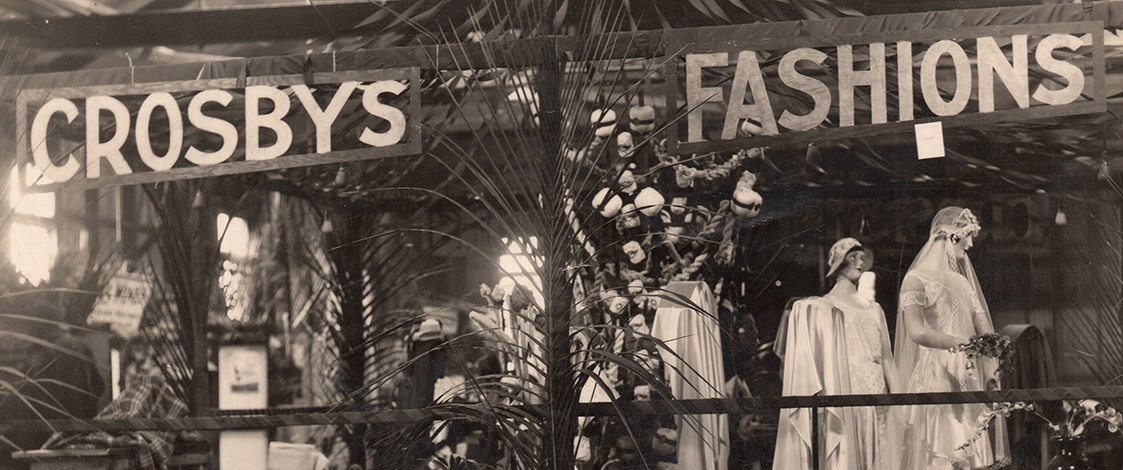
Frank Crosby was an early exponent of vertical retailing; designing, manufacturing and selling his own products first for his eponomous drapery store in Whangarei and later under the name, Reslau Frocks, which were sold in stores across New Zealand, including Jacqueline Gowns, a salon owned by his wife, Alice.
Frank opened Crosby’s, located on the corner of Bank and Cameron Streets in Whangarei, in 1919. He designed frocks and blouses and manufactured everything in-house, allowing him to keep his prices low. Advertisements in the The Northern Advocate promised: "For the latest creations in Evening Blouses, or a Dainty Afternoon Blouse of crepe de chine, silk or voile, and the cheap and neat Morning Blouses, can all be bought at Crosby’s at a price far below ordinary wholesale prices."
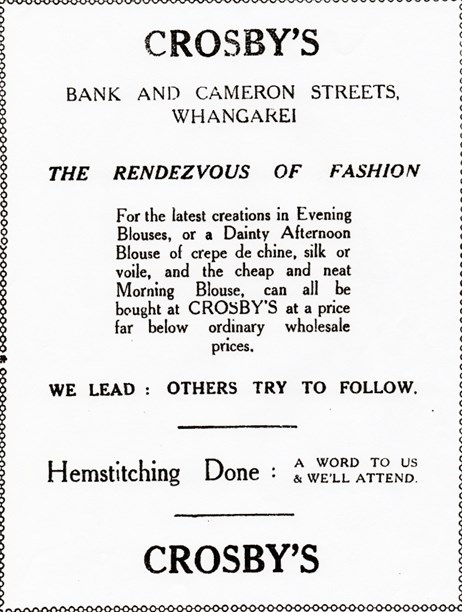
Almost all garments at Crosby’s were designed and manufactured in-house, keeping costs down "far below ordinary wholesale prices".
Another early innovation was that Crosby’s included a hemstitching department and offered this service to local makers. The decorative open work stitching was a fashionable way to trim garments at the time, and prior to Crosby’s opening, Whangarei women would have to create this by hand stitching or post blouses to Auckland to get this design feature added.
By 1921, Crosby’s also included Millinery Showrooms, located further down Cameron Street. Frank employed several milliners whose designs were supplemented by "a splendid line of beautiful models in crepe-de-chine, georgette, tulles of all shades … made up in the very latest styles and colourings".
Frank regularly visited Auckland to purchase fabric and the accessories that he couldn’t manufacture in Whangarei. He knew the Auckland garment industry well having been in charge of a large soft goods factory in Auckland before the First World War. Following his war service he moved to Whangarei for health reasons.
Crosby’s was known for its window displays. One display of wedding dresses was reported on in the local newspaper. "A window, that for novelty, daintiness and distinctive beauty, will take a lot to excel is that of Mr F. Crosby. The central display, made up to represent bridal fashions of three distinct periods is causing a great deal of favourable comment. The bride of 1886, in an early Victorian model of georgette and white satin, is, to the mind of today, altogether quaint and charming. That of 1900, although still quaint to the modern idea, was actually worn by a lady during that period, and excited a great deal of comment at the time for its beauty of design. This frock is cream satin. The 1928 bride is the last word in exquisite charm, and proves conclusively that trousseaux of the daintiest design can be evolved and executed by this firm." (The Northern Advocate, 16 May 1928).
By 1937, the Crosby family had left Whangarei and returned to Auckland where they opened a garment manufacturing factory, Reslau Frocks. The name came from the city of Breslau in Germany. Although Frank had no heritage that connected him to Breslau, the name caught his eye and he thought that by dropping the B he would have a catchy trade name.
Reslau Frocks was initially located on High Street. In December 1940 the business moved to a three-storied building located at 39 Elliott Street, just doors down from fabric wholesaler Snow Rainger. Three years later Frank bought the building for £9,900.
At this time the company was employing about 100 staff as machinists and cutters. Frank and Alice’s daughters worked for the business; Zelda worked in the office, Jean was one of the cutters, and Betty was a house model. Richard, the only son, chose not to work at Reslau.
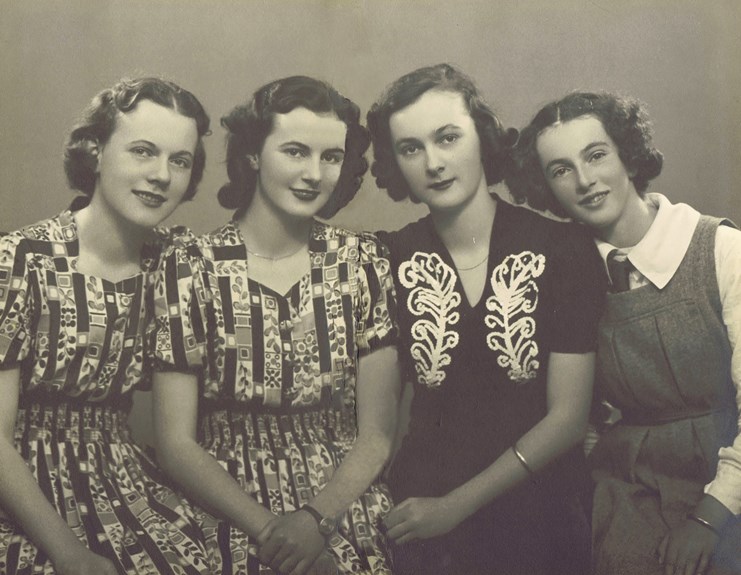
Zelda, Betty and Jean Crosby wearing Reslau (Patty is in her school uniform). Zelda and Betty weren’t impressed when they turned up for the photo with the same dress on. Image courtesy of Justine Neal.
On the ground floor was the office and Frank’s cutting and design area. The machinists occupied the first floor and another designer with two cutters worked on the second floor. The top floor was the lunch room. Zelda Crosby recalls: "The basement was like magic to me stacked full of wonderful materials, ones you never see today. Reslau was a very busy place with the summer and winter range being designed, samples made for travellers and frocks being packed and sent, another one of my jobs."
The two travellers (travelling salesmen), one for the South Island and one for the North, ensured the label was stocked all over New Zealand. Buyers also visited the factory, prompting Frank to call on his daughters to model garments in the showroom. One of Reslau’s local stockists was Alice’s salon, Jacqueline Gowns, which was located at 94 Queen Street.
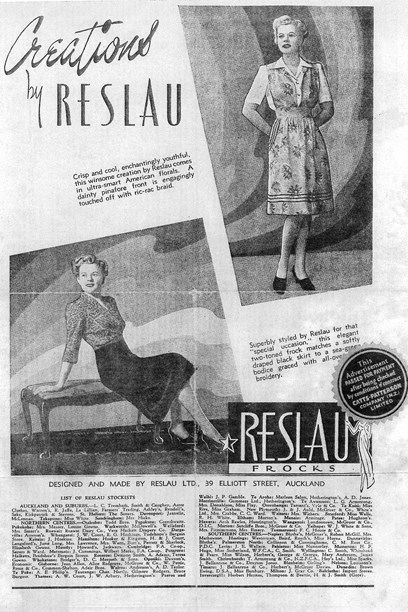
Reslau was stocked all over New Zealand.
Frank and his designer created the ranges. They were inspired by fashion magazines, usually out of date by the time they made it to New Zealand, and by a few garments that they sourced from Australia.
Zelda often travelled to Australia on the American Matson Line ships, the Monterey and the Mariposa, and brought back examples of the latest fashions as inspiration. "We were not allowed to take out much money at that time - it would have been at the beginning of the Second World War - so Dad used to wrap the money in cloth and put it under my underwear to get the money into Australia."
During the war years, shortages of materials meant there were a lot of restrictions. The government regulated the amount of material that could be used for each garment. Zelda said that Frank found this incredibly frustrating. "I used to see him getting into a real anger with inspectors that would call every so often to measure garments."
Around the time of the end of the war, Frank and Alice sold both Reslau Frocks and Jacqueline Gowns. Zelda remembers Frank telling her: "Take what you want, I have sold up. I am tired of all the restrictions." C B Store - specialists in manchester and dress goods - opened in place of Jacqueline Gowns in October 1944.

Newspaper ad for Reslau Exclusives, 1946.
Sadly, in the late 1940s, Frank’s health deteriorated rapidly and he died at 53 in 1948. His was a varied career; as well as designer and business owner, electoral rolls from the early 20th century also record his occupation as porter, tram conductor and fruiterer. Reslau Frocks continued for several more years under new owners who commissioned the fashion photographer Clifton Firth to photograph their designs.
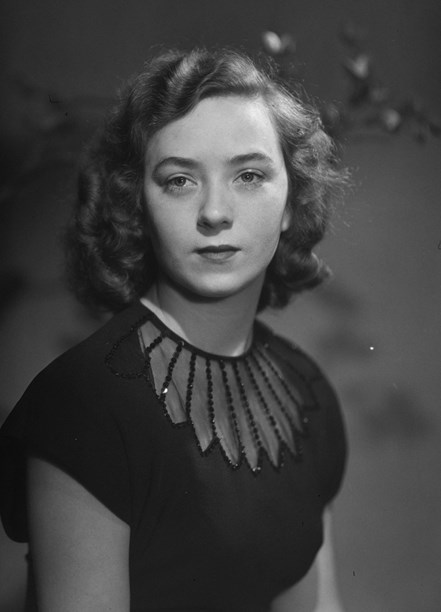
Miss M Brown modelling a Reslau design, 1948. Photo by Clifton Firth, courtesy of Auckland Libraries Heritage Collections, 34_B636.
The most recent photos, taken outside onboard the Rangitata, are dated 1950.
Text by Kelly Dix. Banner image of Crosby’s in Whangarei courtesy of Justine Neal.
Published January 2017.